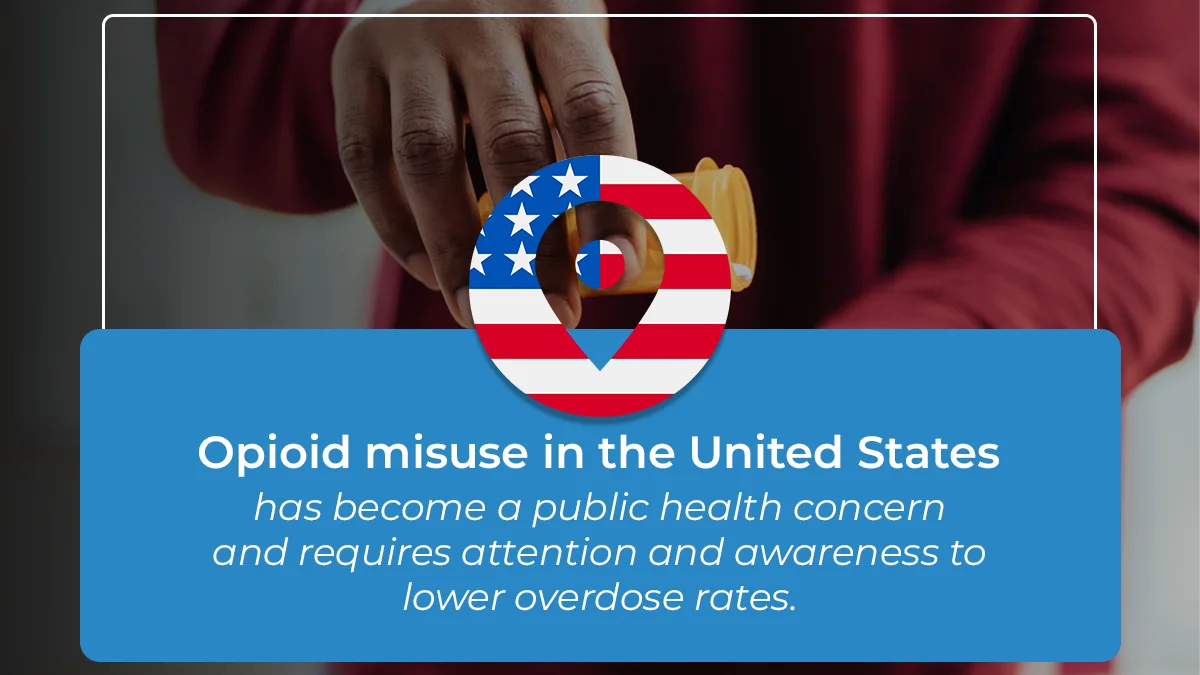Exploring Long-Term Effects of Opioids
Opioids are commonly used in the United States to manage severe pain, often in patients experiencing chronic pain after surgery. While opioids can bring relief, they may lead to long-term physical and mental health problems.
People must use opioids responsibly, as misuse can result in opioid use disorder. Drug abuse can worsen the overall well-being of a person and impact their overall lifestyle. Doctors play a vital role in guiding patients through pain management, ensuring effective addiction treatment while minimizing the risk of complications.
Key Takeaways
Opioids, commonly used for chronic pain, can lead to long-term health problems and addiction risks. Here’s what you need to know:
- Opioid misuse in the United States has become a public health concern and requires attention and awareness to lower overdose rates.
- Prolonged opioid use heightens the risk of developing long-term effects affecting overall well-being.
- Preventing opioid problems involves harm reduction practices and close patient monitoring.
The Recovery Team is here to offer treatment to help you break free from addiction. Call us today at (800) 817-1247.
How Opioids Impact Brain Function
Opioids are powerful pain-relieving substances that work by attaching to specific proteins called opioid receptors in the brain, spinal cord, and other areas of the body. These receptors are part of the body’s natural pain control system.
When opioid molecules bind to these receptors, they block pain signals and release large amounts of dopamine, creating a sense of euphoria and relaxation. This action not only alleviates pain but also induces a feeling of well-being.
However, opioids can also slow down vital functions like breathing, leading to potential dangers, especially in high doses. It’s crucial to use opioids exactly as prescribed by healthcare professionals to minimize the long-term effects and addiction.
Battle Against Drug Epidemic
A serious and deadly drug crisis is happening in the United States due to opioids like fentanyl, heroin, and new synthetic opioids. Unfortunately, the Centers for Disease Control and Prevention (CDC) reports that over 105,000 drug overdose deaths occurred in the United States in October 2021.
This crisis is widespread and affects many people. The use of powerful opioids contributes significantly to the problem, leading to a surge in overdose incidents.
The situation is alarming, with various opioids causing harm and posing a substantial threat to public health. Addressing this crisis requires urgent attention and collaborative efforts from healthcare professionals, policymakers, and the community to implement effective strategies that prevent the misuse of opioids.
Common Effects of Opioids Use
The use of opioids, including prescription painkillers, for the management of chronic pain patients has become increasingly prevalent. While these medications are designed to alleviate pain, their short-term effects can have a significant impact on individuals. Understanding the common effects and potential risks associated with the use of opioids is crucial, especially given the rise in the use of these medications.
Pain Relief: Opioids are primarily prescribed to provide relief from moderate to severe pain. These drugs are often used for patients after major surgery or dealing with cancer to improve their quality of life.
Euphoria and Relaxation: The analgesic properties of opioids may lead to feelings of euphoria and relaxation, contributing to their potential for misuse.
Sedation and Drowsiness: One of the side effects of opioid therapy is sedation and drowsiness, impacting an individual’s alertness and cognitive function.
Nausea and Constipation: Opioid use commonly results in gastrointestinal side effects, such as nausea and constipation, affecting the overall well-being of the patient.
Respiratory Depression: A critical concern associated with the use of opioids is respiratory depression, where breathing becomes slow and shallow, posing a risk of life-threatening consequences.
While opioids can provide relief to individuals, it is essential to recognize the potential risks and side effects associated with their use.
Long-Term Use
For individuals undergoing the treatment of chronic pain through long-term opioid therapy, it’s essential to recognize the potential transitions that can occur as part of this extended use. These transitions involve factors like tolerance, physical dependence, and psychological dependence. Each of these factors plays a role in the development of severe opioid use.
Development of Tolerance
As the body becomes accustomed to the presence of opioid medicines over time, a phenomenon known as tolerance may occur. That means that the same dose of opioids may not provide the same level of pain relief as it once did.
Consequently, individuals might find themselves needing a higher opioid dose to achieve the desired effect. However, this escalation poses a higher risk of complications, including opioid misuse.
Physical Dependence
Long-term opioid treatment can lead to physical dependence, where the body adapts to the continuous presence of drugs. When someone becomes physically dependent, discontinuing the medication or significantly lowering doses may result in withdrawal symptoms. Individuals and healthcare providers must navigate the fine balance between managing severe chronic pain and mitigating the risks associated with physical dependence.
Psychological Dependence
Beyond the physical aspects, long-term opioid use can also contribute to psychological dependence. Individuals may develop a reliance on opioids not only for managing physical pain but also as a coping mechanism for mental distress.
This psychological dependence can be challenging to address. That is why doctors necessitate a comprehensive approach, such as dual diagnosis, that considers mental health and the effects of addiction.
How Prolonged Use Affects Physical Health and Mental Well-Being
Prolonged opioid use poses various risks, impacting physical health. It may paradoxically lead to increased sensitivity to pain, exacerbating chronic pain. Opioid use disorder can contribute to bowel dysfunction, potentially leading to bowel obstruction.
Misuse of prescription pain relievers with opioids is a risk factor for respiratory problems. Long-term opioid use may contribute to elevated blood pressure, impacting cardiovascular health negatively. Not only this, it can also result in low levels of testosterone, leading to sexual dysfunction.
The lasting physical effects highlight why it’s important to be careful when prescribing opioids. Healthcare professionals need to be aware of the possible impact on health and the dangers linked to drug misuse. The long-term effects of opioid use extend beyond the physical realm, significantly affecting mental health.
Prolonged opioid use, especially with higher doses, is associated with an increased risk of depression. It may also contribute to the development of anxiety disorders and cognitive impairment. Individuals with opioid use disorder often are more vulnerable to having co-occurring mental health disorders.
Collectively, these mental health consequences contribute to a visible impact on the overall quality of life for adults. That emphasizes the need for holistic care and support to address both the physical and mental dimensions of opioid use.
The Behavioral Fallout
Extended use of opioid medications, including the risk of illicit opioids, brings about significant behavioral consequences. Individuals facing chronic pain may find themselves entangled in a complex web where the allure of relief collides with the risk of opioid use disorder.
The behavioral fallout involves the individual, their relationships, and societal engagement. A person dealing with addiction is likely to perform poorly at jobs and prefer isolation from their loved ones. Understanding and addressing these consequences become crucial in fostering supportive environments and mitigating the impact of opioid dependence on overall well-being.
When to Seek Help for Addiction
Recognizing the symptoms of addiction and knowing when to seek help is crucial for individuals and their loved ones. Common signs include a loss of control over drug use, continued use despite negative outcomes, withdrawal symptoms, and a preoccupation with obtaining and using the substance.
Additional red flags include a poor diet, neglect of responsibilities, and declining physical health. If substance use is impacting one’s physical or mental health, interfering with daily life, or causing distress, seeking help is imperative.
Strategies for Treatment and Prevention
Dealing with the problems caused by drug abuse requires using different ways to prevent and help. One important method is looking at how doctors prescribe medications to lower the chances of opioid misuse. Instead of just giving out prescriptions, doctors can be more cautious and make sure they’re making informed choices.
Changes in Prescription Practices
Doctors and healthcare providers can help prevent or reduce problems with opioids by taking a closer look at how they prescribe these medications. They should think about whether opioids are really necessary for managing pain.
Doctors can prescribe lower amounts if needed to reduce the risk of issues. When possible, they might suggest other options for pain relief that don’t involve opioids. Healthcare providers need to keep patients under medical supervision using opioids, making sure they’re okay and not facing any problems.
Medication-Assisted Treatment
Medication-assisted treatment (MAT) is a pivotal intervention strategy. MAT involves using medications to manage withdrawal symptoms and cravings while concurrently providing behavioral therapy.
This comprehensive approach aids individuals in overcoming opioid addiction by highlighting both the physical and mental aspects of dependence. Medications like methadone, buprenorphine, and naltrexone have demonstrated efficacy in supporting recovery.
Peer Support, Therapy, and Rehabilitation
Another integral aspect of intervention is incorporating peer support, therapy, and rehabilitation. Peer support programs allow participants to connect with others who have faced similar challenges, fostering understanding and encouragement.
Therapeutic interventions, such as cognitive-behavioral therapy, assist in addressing underlying issues contributing to addiction. Rehabilitation programs provide structured environments for individuals to undergo treatment and develop coping skills essential for sustained recovery.
Rebuild Sober Life At The Recovery Team
Opioids are well known for their effect on people dealing with pain. However, this drug is highly addictive, and if you or your loved one is dealing with opioid addiction, then you are in the right place to seek help.
The Recovery Team offers opioid addiction treatment under medical care and uses anti-craving programs to help deal with withdrawal symptoms. Our residential rehab provides a friendly environment and holistic approaches such as therapies and counseling to improve your chances of recovery.
We are looking forward to being part of your recovery journey. Contact us at (800) 817-1247 today.






